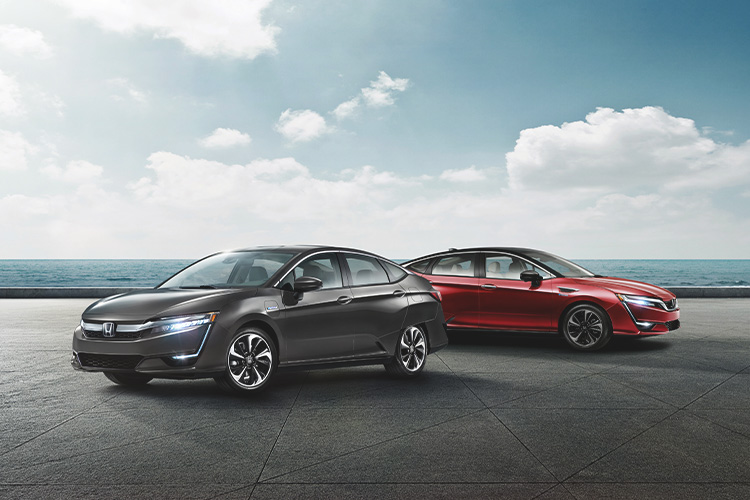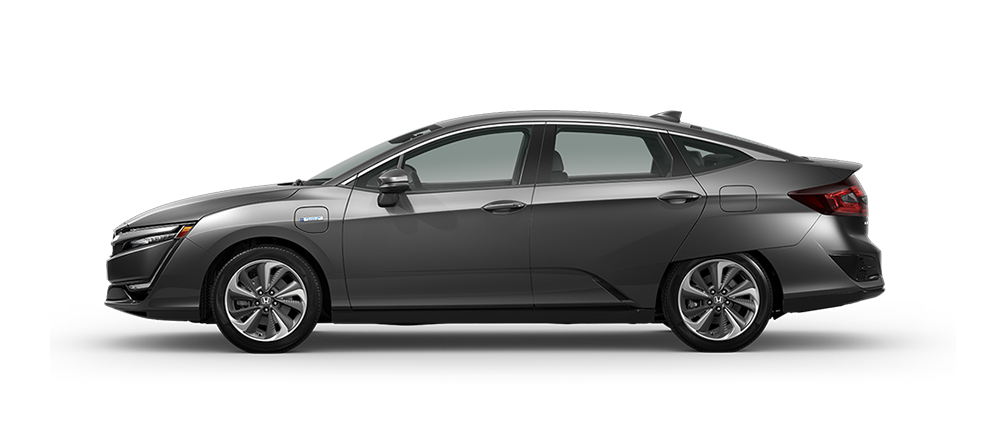The Clarity Series
Find the Clarity for you.
Benefits
Frequently Asked Questions
Plug-in hybrid vehicles like the Clarity Plug-In Hybrid use high-powered batteries to power an electric motor, and another fuel, such as gasoline or diesel, to power an internal combustion engine.
They run on electric power, storing enough electricity in the battery to significantly reduce gasoline usage under typical driving conditions. When driven in EV mode they produce zero emissions, and when the battery becomes depleted or additional power is required, the vehicle automatically switches over to the traditional gas-powered engine.
Plug-in hybrids can be charged by plugging them into an electrical outlet or charging station, through regenerative braking or through the internal combustion engine.
A fuel-cell vehicle (FCV), such as the Clarity Fuel Cell, is a long-range all-electric vehicle that uses a fuel-cell stack to create electricity on demand.
Although it’s an electric vehicle, there is never a need to “charge” the car with a plug. Instead, it can be simply refueled in 3 to 5 minutes at a hydrogen station. Since the Clarity has a 360-mile range rating*, the time between fill-ups is similar to what you would experience in a traditional gasoline-powered vehicle—except the Clarity produces zero emissions. In fact, the only byproduct of this power source is water vapor.
While both powertrains use an electric drive motor, there are several differences that allow each vehicle to suit various lifestyles and driving uses.
Fuel-cell vehicles typically have range ratings of 300 miles or more and refueling times of approximately 5 minutes or less, along with a highly efficient fuel cell to create the on-demand electricity for power, with no emissions.
Plug-in hybrid vehicles use a traditional gasoline engine as well as an electric motor with a battery to allow all-electric driving capability. By utilizing this hybrid powertrain, the vehicle can be driven fuel-efficiently for long driving distances. When driven in EV mode, it produces zero emissions. The battery can be recharged from a power outlet much like a battery-electric vehicle.
The Clarity Plug-In Hybrid has an onboard rechargeable battery that stores energy to power the electric motor. The battery can be charged by plugging your Clarity Plug-In Hybrid into an outlet at home, work or any public charging station. There are two ways to charge, and both are accessible through the port located on the front left fender.
• Level 1 charging can be done by plugging the vehicle into a 120-volt household outlet, and is convenient with the Level 1 120-volt adaptor that comes standard with the vehicle. It’s recommended that a dedicated 120-volt GFCI outlet (not shared) with a 15 amp circuit be used and that a licensed-electrician confirm the suitability of any outlet used.
• Level 2 charging is a fast and convenient way to charge, requiring a 240-volt charger, and available at public charging stations nationwide. You can also install a Level 2 charging station at your home. There are many choices for home charging, with equipment available from reputable manufacturers such as Leviton, Bosch, Clipper Creek, and many others. We recommend that a licensed electrician that has experience with these types of installations install it. A third-party article with good information can be found here.
Fueling your Clarity Fuel Cell is as simple as fueling a traditional gasoline-powered car and can be done in 3 to 5 minutes. Your Clarity dealer can provide simple instructions for refueling, and most hydrogen dispensers also provide on-screen training prompts to guide you through the fueling process.
When you first pull up to a hydrogen dispenser, you will be prompted to follow each successive step. While most dispensers will have two available pressures, and the Clarity is capable of using both, be sure to select the H70 pressure option to help maximize your range. When fueling is complete, you will be prompted to disconnect the nozzle and carefully return it to the dispenser. Your total will be deducted from your fuel payment card*.
Owners of hybrid or alternative-fuel vehicles can be eligible for up to $7,500 in federal tax credits. Some states also offer rebates and additional tax credits. These incentives can change frequently. View a list of incentives by state here.
Electric utilities may offer reduced electricity rates for electric vehicle owners. Also, several major car insurance companies offer discounts to EV owners. More potential benefits include rebates for home charger installation, free or preferred public parking, free charging at certain businesses, and reduced toll fees. Sacramento, CA, for instance, offers free parking and charging at public garages, and PG&E offers reduced rates for residential EV charging. Contact your utility and individual businesses for more information.
The Clarity Plug-In Hybrid is available for purchase or lease at all Honda dealerships nationwide and the Clarity Fuel Cell is available for lease at participating dealers in California.
Awards

2020 Best Buy: Electric/Hybrid Car
Kelley Blue Book’s KBB.com2020 Best Buy: Electric/Hybrid Car
With a class-leading* 47-mile all-electric range rating,* seating for five and Honda Sensing® standard, the Honda Clarity Plug-In Hybrid has been named 2020 Best Buy of the Year among electric and hybrid cars by Kelley Blue Book’s KBB.com.*
Kelley Blue Book’s KBB.com



